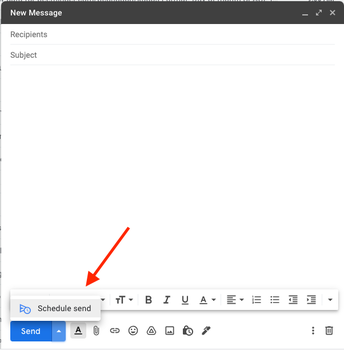One of my favorite features in Gmail is the ability to schedule an email to be sent in the future. Other email clients, like Thunderbird1, have this capability as well. I think of this feature not as “scheduling an email to be sent at a specific time”, but rather as “deferring sending the email for a period of time”. Put another way, scheduling emails to be sent is the equivalent of composing a reply, putting it in your outbox, and automatically flushing that outbox at some later time.

Gmail’s ‘Schedule Email’ feature
Here are some of the benefits I’ve found:
Scheduling reduces typos. I have an irrational fear of making typos in emails. In the grand scheme of things, typos are no big deal. But, no one wants to have to send one of those apologetic “oops, wrong date” or “oops, forgot to paste the right link” followup emails – especially if you’re sending an announcement to a list with a bunch of people on it.
Scheduling emails gives you the flexibility to fix mistakes after you’ve committed to sending the message, but before it gets sent. This is kinda like Gmail’s “undo send” feature, just with a longer latency. I often see mistakes in emails right as I click send, so having a window of time to go back and revise if I really need to is helpful.
Scheduling reinforces email’s asynchrony. This is a normative statement, but: email should be treated as an asynchronous communication channel. If an email conversation receives more than a few messages per day, I take that as an indication that the conversation should be moved to a more direct medium; either a video call or (once the pandemic ends) an in person meeting. Enforcing a few hours between writing a response and the response being sent makes it so that if something is urgent enough to warrant a quick response, it’s escalated to a lower latency channel.
Scheduling reduces “send dread”. I used to really dread sending important emails. I’d scrutinize every word, and then even when I was sure I’d crafted the perfect message, I would still hesitate for a long time on the “send” button. Scheduling alleviates this “send dread”: it transforms the actual sending of a message from something that you have to positively enact, to something that will happen unless you prevent it. This is similar to the “reducing typo” reasoning, in that creating a grace period from “this email is done” to “this email is sent” reduces the mental barrier to finalizing an email.
Scheduling allows you to signal your working hours. Occasionally, I check email at odd hours, but I guard my consistent “working hours”. Deferring an email to be sent within the standard 9-5 window prevents creating an expectation that you’re available at all time – and also prevents the awkward “why did this person email me at 11pm” effect. Ironically, I tend to use this tip more for personal emails than work emails (since I try hard not to check work email outside of business hours).
Scheduling emails to yourself acts as a lazy reminder system. Yes, you probably shouldn’t use your Inbox as a to-do list. But, if you do, then scheduling an email to yourself works as a great simple reminder system. Just dump some context in the subject, and fire off the message to yourself – scheduled when you want to be notified.
Ultimately, email scheduling isn’t useful for becoming More Productive™️. If you want to be More Productive™️, then I guess check your email all the time and respond as quickly as possible. Scheduling lets you define a slower pace of email communication, reduces some of the anxiety around sending important emails, and allows you to maintain your expectation of working hours. So, I’ve found it useful.
Cover: Unsplash
-
“How to set up an email to be sent in future”, from the Thunderbird forums ↩︎